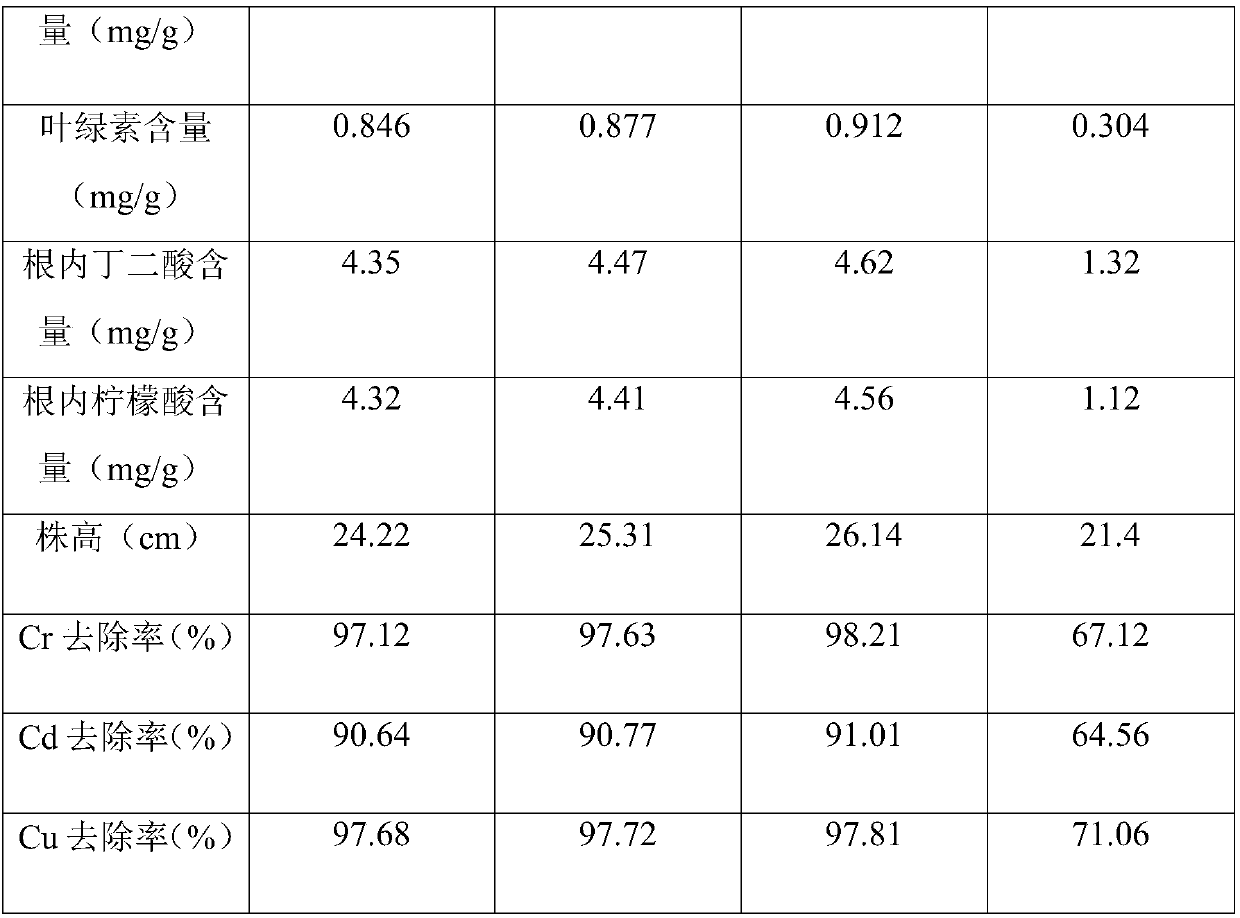Adsorbent based on photosynthetic spore bacterium treatment of soil heavy metals, and preparation method thereof
A technology of photosynthetic spores and heavy metals, applied in the restoration of polluted soil, chemical instruments and methods, bacteria, etc., can solve the problems of hindering the normal growth and development of plants, the limited depth of root system expansion, and the disorder of cell metabolism, so as to promote super-rich Integrates plant growth, enriches microbial flora, and reduces metabolic disturbances
- Summary
- Abstract
- Description
- Claims
- Application Information
AI Technical Summary
Problems solved by technology
Method used
Image
Examples
Embodiment 1
[0019] Example 1: Weigh 300g of agricultural and forestry waste and add it to a pulverizer for crushing, pass through a 100-mesh sieve, put the sieved agricultural and forestry waste powder into a drying box, dry at 70°C to constant weight, and then transfer to a muffle furnace In an argon atmosphere, heat to 700°C, keep the temperature for carbonization for 20min, and cool to room temperature to obtain activated carbon from agricultural and forestry waste; weigh 80g of zeolite, 30g of vermiculite, and 100g of activated carbon from agricultural and forestry waste, put them into a ball mill, and 200r / min ball mill for 1h, pass through a 200 mesh sieve, then mix evenly with 30g mass fraction of 1% ferric chloride solution, adjust the pH to 9 with ammonia water, filter the filter residue, wash the filter residue 3 times with deionized water, transfer the filter residue to In a drying oven, dry at 105°C to constant weight, then transfer to a muffle furnace, heat to 600°C for calcin...
Embodiment 2
[0020]Example 2: Take 400g of agricultural and forestry waste and add it to a pulverizer for crushing, pass through a 100-mesh sieve, put the sieved agricultural and forestry waste powder into a drying box, dry at 108°C to constant weight, and then transfer to a muffle furnace In an argon atmosphere, heat to 850°C, keep the temperature for carbonization for 25min, and cool to room temperature to obtain activated carbon from agricultural and forestry waste; weigh 90g of zeolite, 40g of vermiculite, and 120g of activated carbon from agricultural and forestry waste, put them into a ball mill, and 220r / min ball mill for 1.5h, pass through a 200 mesh sieve, then mix evenly with 40g mass fraction of 1% ferric chloride solution, adjust the pH to 9 with ammonia water, filter the filter residue, wash the filter residue 4 times with deionized water, transfer the filter residue to into a drying oven, dried at 108°C to constant weight, then transferred to a muffle furnace, heated to 650°C ...
Embodiment 3
[0021] Example 3: Weigh 500g of agricultural and forestry waste and add it to a pulverizer for crushing, pass through a 100-mesh sieve, put the sieved agricultural and forestry waste powder into a drying box, dry at 110°C to constant weight, and then transfer to a muffle furnace In an argon atmosphere, heat to 900°C, keep the temperature for carbonization for 30 minutes, and cool to room temperature to obtain activated carbon from agricultural and forestry waste; weigh 100g zeolite, 50g vermiculite, and 150g activated carbon from agricultural and forestry waste, put them into a ball mill, and 300r / min ball mill for 2h, passed through a 200 mesh sieve, mixed evenly with 60g mass fraction of 1% ferric chloride solution, and adjusted the pH to 10 with ammonia water, filtered to obtain the filter residue, washed the filter residue with deionized water for 5 times, and transferred the filter residue to In a drying oven, dry at 110°C to constant weight, then transfer to a muffle furn...
PUM
 Login to View More
Login to View More Abstract
Description
Claims
Application Information
 Login to View More
Login to View More - R&D
- Intellectual Property
- Life Sciences
- Materials
- Tech Scout
- Unparalleled Data Quality
- Higher Quality Content
- 60% Fewer Hallucinations
Browse by: Latest US Patents, China's latest patents, Technical Efficacy Thesaurus, Application Domain, Technology Topic, Popular Technical Reports.
© 2025 PatSnap. All rights reserved.Legal|Privacy policy|Modern Slavery Act Transparency Statement|Sitemap|About US| Contact US: help@patsnap.com


